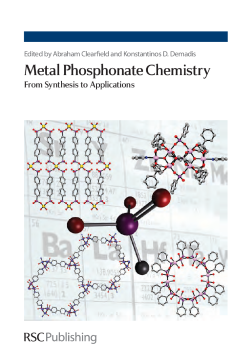
BOOK
Metal Phosphonate Chemistry
Thomas Albrecht-Schmitt | Bruno Bujoli | Christopher Cahill | R Murugavel | Joao Rocha | Gary Hix | George Shimizu | Jon Zubieta | Jerzy Zon | Ernesto Brunet | Richard Winpenny | Paul A Wright | Norbert Stock | Jiang Gao Mao | Li-Min Zheng | Abraham Clearfield | Konstantinos Demadis
(2011)
Additional Information
Book Details
Abstract
Metal phosphonate chemistry is a highly interdisciplinary field, as it encompasses several other areas, such as materials chemistry, gas storage, pharmaceutics, corrosion control, classical chemical synthesis, X-Ray crystallography, powder diffraction, etc. It has also acquired additional significance due to "Metal-Organic Frameworks", as evidenced by the hundreds of papers published each year. Currently there is no other book on the topic and this book fills the gap in the literature by summarising in a concise way the latest developments in the field. Metal phosphonate chemistry has seen impressive growth in the last 15-20 years and there is a clear need to systematize and organize all this growth. This unique book accomplishes just that need - edited by two experts, it includes contributions from other experienced researchers and organises, cateqorises and presents in an attractive way the latest hot topics in metal phosphonate chemistry and related applications. With an extensive bibliography, it is a great reference for academic and industrial researchers as well as students working in the field and will act as a starting point for further exploration of the literature. It is also of great interest to scientists working in the broader area of metal-organic frameworks and their applications.
Abraham Clearfield's research interests are focused on solid state and materials chemistry and encompass a wide variety of projects. An important goal is the ability to design and synthesize new materials whose structure and properties can be predicted and controlled. Layered compounds are amenable to manipulation to produce new structures because of the weak forces between layers and his group have learned how to separate the layers of several classes of compounds and are reconstituting them into novel materials. For example, photochemically active species may be encapsulated to produce permanently porous structures of controlled pore size - such compounds may prove to be selective catalysts. Layered proton conductors and self-assembled supramolecules of novel structures and properties have been prepared and some of these find utility in the separation of radioactive ions from nuclear waste. Zeolites are among the most powerful and versatile catalysts known and Professor Clearfield's group have initiated a program to synthesize new materials with pores in the 10-20+ range. These materials include organic-inorganic hybrids as well as mixed metal oxides. Single crystal X-ray diffraction has been the key tool in elucidating the structure of solids and for many compounds, single crystals are unavailable so that indirect methods need to be used. His group have pioneered the solution of crystal structures from X-ray powder data and have had considerable success but the methods need to be improved and extended to more complex systems such as poorly crystallized materials. Combined use of X-ray, neutron and synchrotron methods are in progress and extension to EXAFS and amorphous scattering techniques is contemplated. Addition of layered materials to polymers is his group's most recent project. Complete dispersal of the layers within the polymer has been obtained and properties of the composite determined and they are now using layered nanoparticles for drug delivery with a focus on breast cancer. The research interests of Konstantinos D Demadis and his group include synthesis and structural characterization of metal phosphonate frameworks, and crystal engineering with an emphasis on hybrid materials synthesis. Applications that result from these efforts include gas sorption and storage, corrosion control, and interface chemistry. Other research interests include colloidal silica and silicates-containing composite materials, mechanistic studies on formation and dissolution of colloidal silica, and effects of polymers on colloidal silica properties. Silicon chemistry is pursued based on bioinspired and biomimetic approaches. The research projects are augmented by a multitude of analytical and instrumental techniques, such as solution and solid state NMR, far, near and mid FT-IR, electronic spectroscopy (UV-visible), Scanning Electron Microscopy (SEM), X-Ray Fluorescence, and X-ray chemical crystallography. Thus far, his group thus has published more than 100 peer-reviewed papers, 11 book chapters, 2 books and 2 patents.
